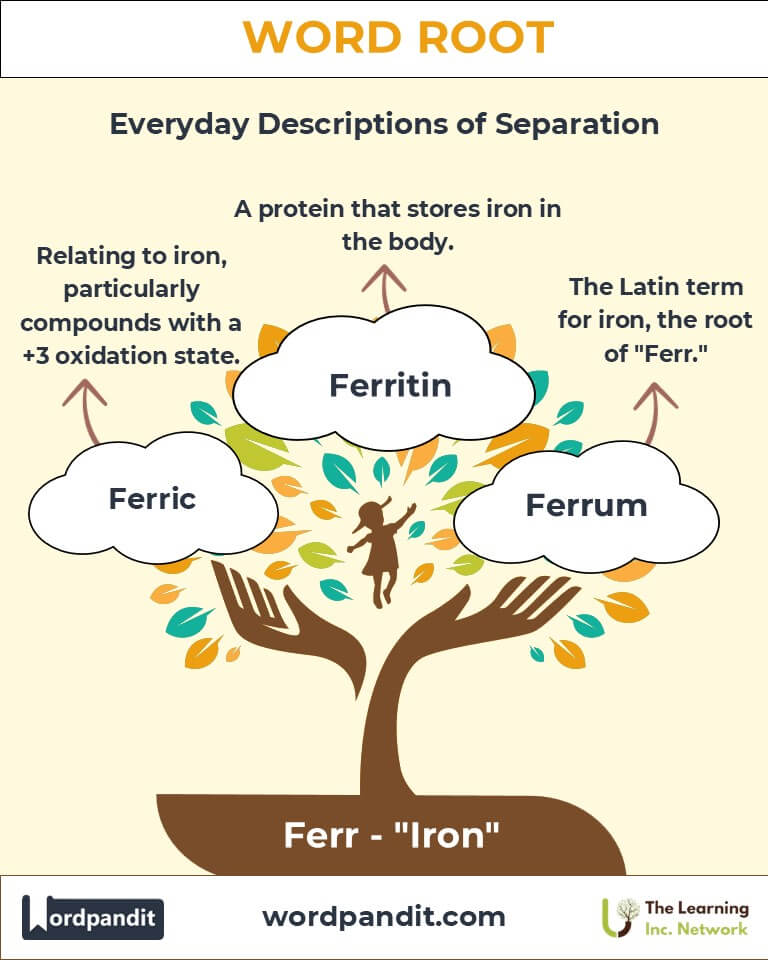Ferr: The Iron Root in Language and Science
Discover the significance of the root "Ferr," derived from the Latin word for iron, and its profound influence across language, science, and technology. Explore terms like "ferrous" and "ferrite," and see how this root shapes our understanding of strength, magnetism, and transformation.

Table of Contents
- Introduction: The Essence of "Ferr"
- Etymology and Historical Journey
- Mnemonic: Unlocking the Power of "Ferr"
- Common "Ferr"-Related Terms
- "Ferr" Through Time
- "Ferr" in Specialized Fields
- Illustrative Story: "Ferr" in Action
- Cultural Significance of the "Ferr" Root
- The "Ferr" Family Tree
- FAQs about the "Ferr" Root
- Test Your Knowledge: "Ferr" Mastery Quiz
- Conclusion: The Living Legacy of "Ferr"
Introduction: The Essence of "Ferr"
The word root "Ferr," pronounced "fair," traces its origins to the Latin word ferrum, meaning "iron." This robust root underpins words related to iron and its derivatives, reflecting the element's importance in human history, science, and technology. From "ferrous," referring to compounds containing iron, to "ferrite," denoting iron-based magnetic materials, "Ferr" conveys strength, utility, and adaptability.

Etymology and Historical Journey
The root "Ferr" originates from ferrum, the Latin word for iron, a material pivotal to ancient civilizations. Iron was essential for tools, weapons, and infrastructure, shaping the Iron Age and beyond. Over centuries, this root expanded its reach through scientific advancements, particularly in chemistry and metallurgy. The introduction of terms like "ferrous" and "ferrite" reflects iron's evolving role in modern science and industry.
Mnemonic: Unlocking the Power of "Ferr"
Imagine a gleaming iron sword forged in fire, embodying strength and resilience. The word "Ferr" shines like that sword, symbolizing the durability and utility of iron.
Mnemonic Device: "Ferr is the force behind iron's fame, forging strength in its name."
Common "Ferr"-Related Terms
- Ferrous ("fair-us"):
- Definition: Pertaining to iron, especially compounds where iron has a +2 oxidation state.
- Example: "Ferrous sulfate is commonly used as an iron supplement."
- Ferrite ("fair-ite"):
- Definition: A ceramic material composed of iron oxides, often used in magnets.
- Example: "Ferrite cores improve the efficiency of electronic circuits."
- Ferruginous ("fer-roo-jin-us"):
- Definition: Containing iron or having a reddish-brown color, resembling rust.
- Example: "The ferruginous soil was ideal for pottery making."
- Ferritin ("fair-it-in"):
- Definition: A protein that stores iron in the body.
- Example: "Low ferritin levels can indicate an iron deficiency."
- Ferric ("fair-ik"):
- Definition: Relating to iron, particularly compounds where iron has a +3 oxidation state.
- Example: "Ferric chloride is used in water treatment processes."
"Ferr" Through Time
- Ferrum: Originating in ancient Rome, this term described the versatile metal shaping civilizations.
- Ferrous vs. Ferric: Scientific distinctions between iron’s oxidation states emerged in the 18th and 19th centuries, marking advancements in chemistry.
- Ferrite’s Emergence: The development of ferrite materials in the 20th century revolutionized magnetism and electronics.
"Ferr" in Specialized Fields
- Medicine:
- Ferritin: Monitors iron storage and deficiency in healthcare diagnostics.
- Relevance: Critical in addressing anemia and iron-related conditions.
- Engineering:
- Ferrous Metals: Includes steel and cast iron, foundational to construction and manufacturing.
- Relevance: Essential in building resilient infrastructure.
- Technology:
- Ferrite Materials: Enhance efficiency in transformers, inductors, and other electronics.
- Relevance: Foundational in modern telecommunications and computing.
Illustrative Story: "Ferr" in Action
In a bustling workshop, Sarah, a materials scientist, developed a new type of ferrite core for high-frequency electronics. Inspired by the strength of ferrous metals and the efficiency of ferrite, her invention revolutionized energy transmission in renewable technologies. Her work, rooted in "Ferr," showcased how ancient materials could drive modern innovations.
Cultural Significance of the "Ferr" Root
Iron's cultural legacy is vast, symbolizing strength and resilience across civilizations. From the iron tools that built ancient empires to the metaphorical "Iron Age," the "Ferr" root reflects humanity’s enduring reliance on this elemental metal.

The "Ferr" Family Tree
- Fer- (Latin: "to bear or carry"):
- Ferry: A vessel carrying goods or passengers.
- Fertile: Capable of bearing fruit or offspring.
- Ferrum (Latin: "iron"):
- Ferrous: Relating to iron.
- Ferric: Pertaining to iron compounds.
- Metall- (Greek: "metal"):
- Metallurgy: The study of metals and their properties.
- Metallic: Having the characteristics of metal.
FAQs About the Ferr Word Root
Q: What does the root "Ferr" mean?
A: The root "Ferr" means "iron," originating from the Latin word ferrum. It forms the basis of words related to iron and its derivatives, reflecting the metal’s importance in history, science, and industry.
Q: What is the difference between ferrous and ferric compounds?
A: Ferrous compounds contain iron in the +2 oxidation state, while ferric compounds contain iron in the +3 oxidation state. For example, ferrous sulfate (FeSO₄) is used in iron supplements, while ferric chloride (FeCl₃) is used in water purification.
Q: What is ferrite used for?
A: Ferrite is a ceramic material made from iron oxides mixed with other metals. It is widely used in magnets, inductors, and transformers due to its magnetic properties and efficiency in conducting magnetic fields while minimizing energy loss.
Q: How does ferritin function in the body?
A: Ferritin is a protein that stores and releases iron in the body. It acts as a reservoir to supply iron when needed for processes like oxygen transport (via hemoglobin) and cellular respiration. Low ferritin levels indicate iron deficiency, while high levels may signal inflammation or iron overload.
Q: Why is iron-rich soil called ferruginous?
A: Ferruginous soil is rich in iron compounds, giving it a reddish-brown color due to oxidation (similar to rust). This soil type is often fertile and is used in agriculture or pottery making in regions where it is abundant.
Q: What is the significance of ferrous metals in construction?
A: Ferrous metals, such as steel and cast iron, are crucial for construction due to their strength, durability, and malleability. They are used in building frameworks, bridges, and machinery, shaping modern infrastructure.
Q: What are ferrite cores, and why are they important?
A: Ferrite cores are components made from ferrite material, used in electrical and electronic circuits to minimize energy loss in transformers, inductors, and antennas. Their high magnetic permeability makes them vital for efficient energy transfer and noise suppression.
Q: What is the role of iron in everyday life?
A: Iron is indispensable for human health and industry. In the body, it is essential for forming hemoglobin, which transports oxygen. Industrially, iron and its alloys (like steel) are the backbone of manufacturing, transportation, and construction.
Q: Are there non-metallic applications of ferrite?
A: Yes, ferrite has non-metallic applications, such as in microwave devices, magnetic cores for radio-frequency circuits, and high-frequency transformers. Its versatility extends beyond metallic uses.
Test Your Knowledge: Ferr Word Root Quiz
1. What does the root "Ferr" signify?
2. Which term describes an iron storage protein in the body?
3. What does "ferrous" refer to?
4. What is ferrite commonly used for?
5. Which term describes reddish soil rich in iron?
Conclusion: The Living Legacy of "Ferr"
The root "Ferr" continues to forge connections between the ancient and modern worlds. From its role in metallurgy to its applications in medicine and technology, "Ferr" reflects the enduring importance of iron in shaping human progress. Embrace the strength of "Ferr" and explore its remarkable impact on our language and lives.












